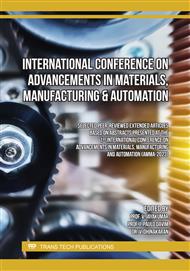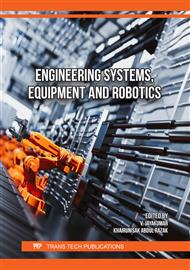[1]
V. Dutta, S. Sharma, K. Chopra, and B. Singh, "Hybrid Electric Discharge Machining Processes for Hard Materials: A Review," Mater. Focus, vol. 5, no. 3, p.202–208, 2016.
DOI: 10.1166/mat.2016.1361
Google Scholar
[2]
E.C.J. (Ed.. E.I. Shobert, "Electrical Discharge Machining: Tooling, Methods and Applications," Soc. Manuf. Eng. Dearbern, Michi- gan, pp.3-4, 1983.
Google Scholar
[3]
N. Jain, B. Bhardwaj, A. Vijay, and G. Jain, "Review on Process Parameter of EDM & micro EDM," 2019, Accessed: Apr. 26, 2022. [Online]. Available: http://www.ijser.org.
Google Scholar
[4]
A. T. Bozdana and T. Ulutas, "The Effectiveness of Multichannel Electrodes on Drilling Blind Holes on Inconel 718 by EDM Process," Mater. Manuf. Process., vol. 31, no. 4, p.504–513, Mar. 2016.
DOI: 10.1080/10426914.2015.1059451
Google Scholar
[5]
A. H. Alamri, "Localized corrosion and mitigation approach of steel materials used in oil and gas pipelines – An overview," Eng. Fail. Anal., vol. 116, p.104735, Oct. 2020.
DOI: 10.1016/J.ENGFAILANAL.2020.104735
Google Scholar
[6]
M. Danish et al., "Enhanced machining features and multi-objective optimization of CNT mixed-EDM process for processing 316L steel," Int. J. Adv. Manuf. Technol. 2022, p.1–17, Apr. 2022.
DOI: 10.1007/S00170-022-09157-5
Google Scholar
[7]
M. Al-Amin et al., "Analysis of hybrid HA/CNT suspended-EDM process and multiple-objectives optimization to improve machining responses of 316L steel," J. Mater. Res. Technol., vol. 15, p.2557–2574, Nov. 2021.
DOI: 10.1016/J.JMRT.2021.09.074
Google Scholar
[8]
Rahul, S. Datta, and B. Bhusan Biswal, "Experimental studies on electro-discharge machining of Inconel 825 super alloy using cryogenically treated tool/workpiece," Measurement, vol. 145, p.611–630, Oct. 2019.
DOI: 10.1016/J.MEASUREMENT.2019.06.006
Google Scholar
[9]
G. Singh Grewal and D. Parkash Dhiman, "Effect of deep cryogenic treatment on copper electrode for non-traditional electric discharge machining (EDM)," Mech. Sci., vol. 10, no. 2, p.413–427, Aug. 2019.
DOI: 10.5194/MS-10-413-2019
Google Scholar
[10]
V. Srivastava and P. M. Pandey, "Performance evaluation of electrical discharge machining (EDM) process using cryogenically cooled electrode," Mater. Manuf. Process., vol. 27, no. 6, p.683–688, Jun. 2012.
DOI: 10.1080/10426914.2011.602790
Google Scholar
[11]
C. P. Mohanty, M. P. Satpathy, S. S. Mahapatra, and M. R. Singh, "Optimization of cryo-treated EDM variables using TOPSIS-based TLBO algorithm," Sadhana - Acad. Proc. Eng. Sci., vol. 43, no. 4, p.1–18, Apr. 2018.
DOI: 10.1007/s12046-018-0829-7
Google Scholar
[12]
R. Goyal, S. Sngh, and H. Kumar, "Performance evaluation of cryogenically assisted electric discharge machining (CEDM) process," Mater. Manuf. Process., vol. 33, no. 4, p.433–443, Mar. 2018.
DOI: 10.1080/10426914.2017.1317789
Google Scholar
[13]
M. Krishna et al., "Application of MOORA & COPRAS integrated with entropy method for multi-criteria decision making in dry turning process of Nimonic C263,".
DOI: 10.1051/mfreview/2022014
Google Scholar
[14]
A. Aherwar, C. I. Pruncu, and M. Mia, "Optimal Design Based on Fabricated SiC/B4C/Porcelain Filled Aluminium Alloy Matrix Composite Using Hybrid AHP/CRITIC-COPRAS Approach," Silicon 2021 142, vol. 14, no. 2, p.603–615, Jan. 2021.
DOI: 10.1007/S12633-020-00916-1
Google Scholar
[15]
K. Shivalingaiah et al., "Stir Casting Process Analysis and Optimization for Better Properties in Al-MWCNT-GR-Based Hybrid Composites," Metals (Basel)., vol. 12, no. 8, p. undefined-undefined, Aug. 2022.
DOI: 10.3390/MET12081297
Google Scholar
[16]
N. A. Sristi, · Prianka, B. Zaman, and N. R. Dhar, "Multi-response optimization of hard turning parameters: a comparison between different hybrid Taguchi-based MCDM methods," Int. J. Interact. Des. Manuf. 2022, p.1–17, Feb. 2022.
DOI: 10.1007/S12008-022-00849-6
Google Scholar
[17]
J. Outeiro, W. Cheng, F. Chinesta, and A. Ammar, "Modelling and Optimization of Machining of Ti-6Al-4V Titanium Alloy Using Machine Learning and Design of Experiments Methods," J. Manuf. Mater. Process. 2022, Vol. 6, Page 58, vol. 6, no. 3, p.58, May 2022.
DOI: 10.3390/JMMP6030058
Google Scholar
[18]
A. Nguyen, V. Nguyen, T. Le, and N. Nguyen, "Multiobjective Optimization of Surface Roughness and Tool Wear in High-Speed Milling of AA6061 by Machine Learning and NSGA-II," vol. 2022, 2022.
DOI: 10.1155/2022/5406570
Google Scholar
[19]
D. Das, D. K. Pratihar, G. G. Roy, and A. R. Pal, "Phenomenological model-based study on electron beam welding process, and input-output modeling using neural networks trained by back-propagation algorithm, genetic algorithms, particle swarm optimization algorithm and bat algorithm," Appl. Intell., vol. 48, no. 9, p.2698–2718, Sep. 2018.
DOI: 10.1007/s10489-017-1101-2
Google Scholar



